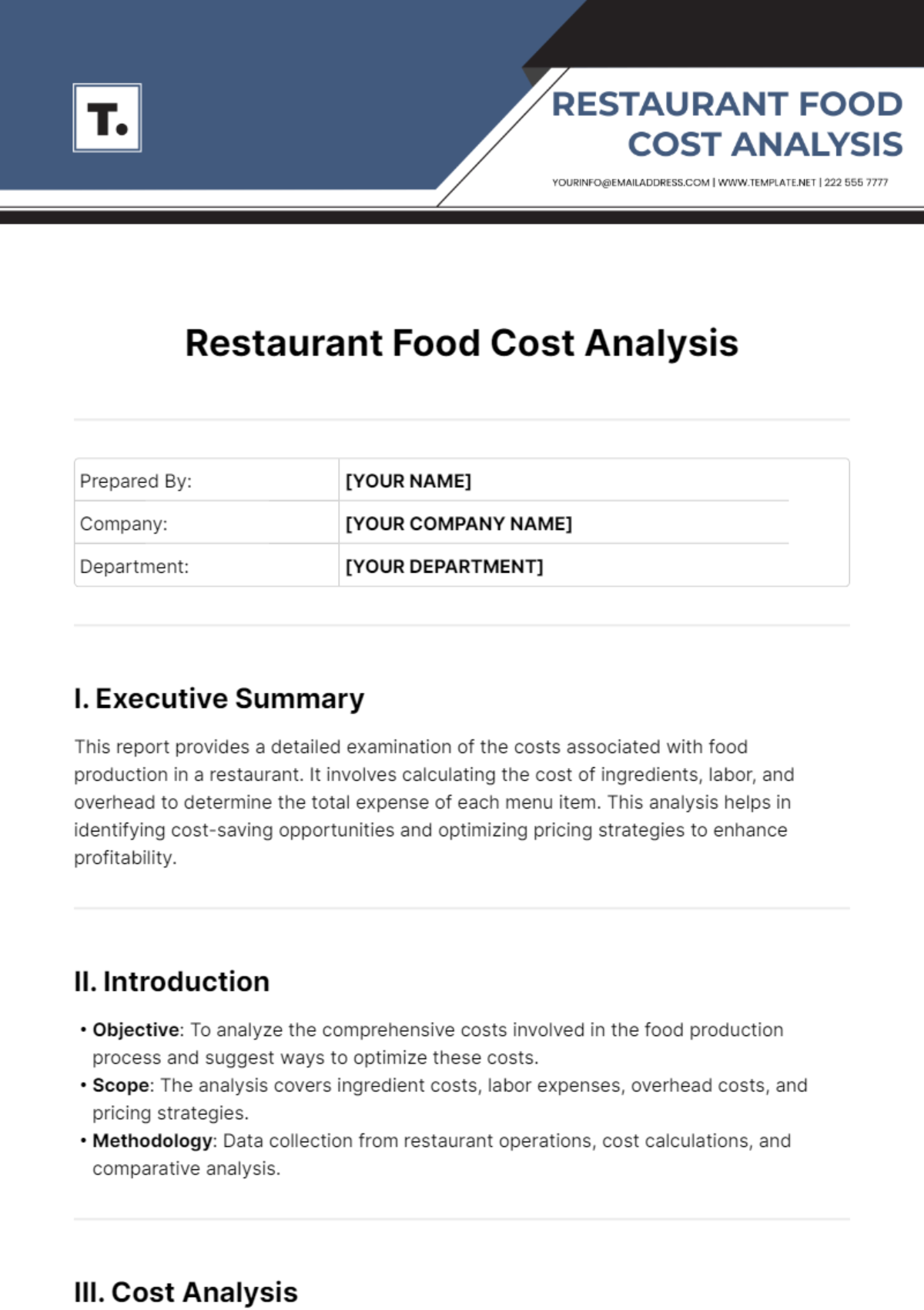Restaurant Food Cost Analysis
Prepared By: | [YOUR NAME] |
Company: | [YOUR COMPANY NAME] |
Department: | [YOUR DEPARTMENT] |
I. Executive Summary
This report provides a detailed examination of the costs associated with food production in a restaurant. It involves calculating the cost of ingredients, labor, and overhead to determine the total expense of each menu item. This analysis helps in identifying cost-saving opportunities and optimizing pricing strategies to enhance profitability.
II. Introduction
Objective: To analyze the comprehensive costs involved in the food production process and suggest ways to optimize these costs.
Scope: The analysis covers ingredient costs, labor expenses, overhead costs, and pricing strategies.
Methodology: Data collection from restaurant operations, cost calculations, and comparative analysis.
III. Cost Analysis
A. Ingredient Costs
Direct Costs of Ingredients
Meat: Cost per unit, total units used, total cost
Vegetables: Cost per unit, total units used, total cost
Dairy Products: Cost per unit, total units used, total cost
Spices and Condiments: Cost per unit, total units used, total cost
Other Ingredients: Cost per unit, total units used, total cost
Ingredient | Cost per Unit | Total Units Used | Total Cost |
|---|
Meat | $10 | 50 | $500 |
Vegetables | $2 | 100 | $200 |
Dairy Products | $3 | 80 | $240 |
Spices and Condiments | $1 | 60 | $60 |
Other Ingredients | $5 | 40 | $200 |
Total | | | $1200 |
Indirect Costs
Transportation Costs: $100 per month
Storage Costs: $200 per month
Spoilage/Wastage Costs: $50 per month
B. Labor Costs
Kitchen Staff Salaries
Chefs: Number of chefs, monthly salary, total cost
Sous Chefs: Number of sous chefs, monthly salary, total cost
Line Cooks: Number of line cooks, monthly salary, total cost
Dishwashers: Number of dishwashers, monthly salary, total cost
Position | Number of Staff | Monthly Salary | Total Monthly Cost |
|---|
Chefs | 2 | $3000 | $6000 |
Sous Chefs | 3 | $2500 | $7500 |
Line Cooks | 5 | $2000 | $10000 |
Dishwashers | 4 | $1500 | $6000 |
Total | | | $29500 |
Additional Labor Costs
C. Overhead Costs
Utilities
Rent and Maintenance
Miscellaneous
Overhead Category | Monthly Cost |
|---|
Electricity | $800 |
Water | $300 |
Gas | $200 |
Rent | $4000 |
Maintenance and Insurance | $1100 |
Licenses and Permits | $100 |
Total | $6500 |
IV. Total Cost Calculation
Cost Category | Monthly Cost | Annual Cost |
|---|
Ingredient Costs | $1200 | $14400 |
Labor Costs | $29500 | $354000 |
Overhead Costs | $6500 | $78000 |
Total | $37200 | $446400 |
V. Cost-Saving Opportunities
A. Ingredient Cost Reduction
Bulk Purchasing: Negotiate bulk purchase deals to reduce per-unit cost.
Local Sourcing: Source ingredients locally to cut down transportation costs.
Waste Management: Implement better inventory and waste management practices to reduce spoilage.
B. Labor Cost Optimization
Flexible Scheduling: Use flexible staffing schedules to reduce overtime.
Cross-Training: Train staff to perform multiple roles, increasing efficiency.
Performance Incentives: Implement performance-based incentives to boost productivity.
C. Overhead Cost Management
Energy Efficiency: Invest in energy-efficient appliances and lighting to reduce utility bills.
Preventive Maintenance: Regular maintenance to prevent costly repairs.
Lease Negotiation: Renegotiate lease terms to secure better rental rates.
VI. Pricing Strategy
A. Menu Engineering
Contribution Margin Analysis: Identify high-margin items and promote them.
Demand-Based Pricing: Adjust prices based on demand patterns.
Seasonal Pricing: Implement seasonal pricing for items with fluctuating ingredient costs.
B. Competitive Analysis
VII. Recommendations
Based on the detailed cost analysis, here are the key recommendations for [Your Company Name] to enhance profitability and efficiency in food production:
A. Optimize Ingredient Procurement
Bulk Purchasing: Negotiate bulk deals for discounts.
Local Sourcing: Source locally to cut transport costs.
Supplier Review: Regularly evaluate suppliers for cost and quality.
B. Improve Labor Efficiency
Cross-Training: Train staff for multiple roles.
Flexible Scheduling: Optimize labor hours with flexible schedules.
Incentives: Introduce performance-based incentives.
C. Reduce Overhead Expenses
Energy Efficiency: Upgrade to energy-efficient appliances.
Preventive Maintenance: Implement a maintenance plan to avoid costly repairs.
Lease Negotiation: Renegotiate lease terms for better rates.
D. Enhance Pricing Strategies
Menu Engineering: Promote high-margin items.
Dynamic Pricing: Adjust prices based on demand.
Value-Added Services: Offer unique dining experiences to justify higher prices.
E. Implement Cost Monitoring
Regular Audits: Conduct regular cost audits.
Management Software: Use software for real-time cost tracking.
Inventory Management: Implement systems to reduce waste.
F. Continuous Improvement
Feedback: Regularly collect feedback from customers and staff.
Benchmarking: Compare with industry standards to maintain best practices.
Innovation: Stay updated with industry trends and innovations.
VIII. Conclusion
This cost analysis provides a comprehensive overview of the expenses associated with food production in a restaurant. By identifying key cost drivers and potential savings opportunities, [Your Company Name] can optimize its pricing strategies and improve overall profitability. Continuous monitoring and regular updates to this analysis will ensure sustained cost efficiency and competitive advantage.
Analysis Templates @ Template.net






























